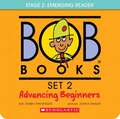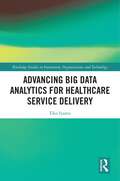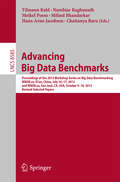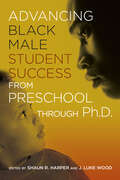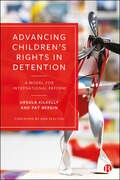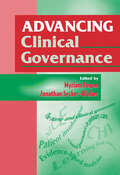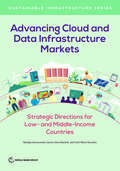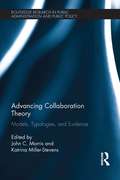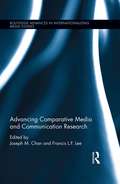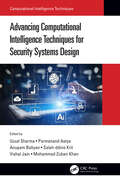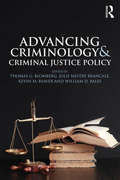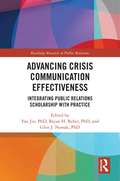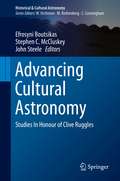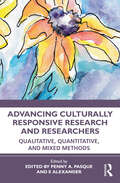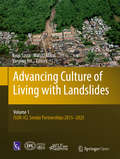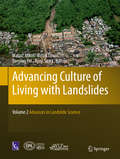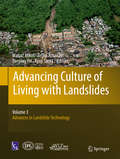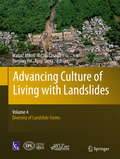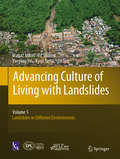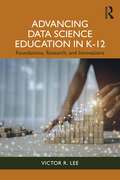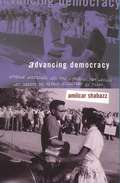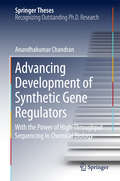- Table View
- List View
Advancing Beginners (Bob Books Set #2)
by Bobby Lynn Maslen John R. MaslenBob Books Set 2-Advancing Beginners continues to build reading skills. Use of three-letter words and consistent vowel sounds in slightly longer stories build confidence. Children love the hilarious (and sometimes mischievous) stories and pictures. These twelve books, filled with fun, drama, and surprise keep interest high for even the youngest readers.
Advancing Big Data Analytics for Healthcare Service Delivery (Routledge Studies in Innovation, Organizations and Technology)
by Tiko IyamuIn recent years, there has been steady increase in the interest shown in both big data analytics and the use of information technology (IT) solutions to improve healthcare services. Despite the growing interest, there are limited materials, to addressing the needs and challenges posed by the activities and processes including the use of big data. From IT solutions’ perspectives, this book aims to advance the deployment and use of big data analytics to increase patients’ big data usefulness and improve healthcare service delivery. The book provides significant insights and useful guide on how to access and manage big data, in improving healthcare service delivery. The book contributes a fresh perspective, which primarily comes from the complementary use of analytics approach with actor-network theory (ANT), and other techniques, in advancing healthcare service delivery. Accessing and managing healthcare big data have always been a challenging exercise. Due to the sensitivity of the health sector, the focus on patients’ big data is from either technical or social perspective. Thus, the book employs sociotechnical theories, ANT and structuration theory (ST) as lenses to examine and explain the factors that enable and constrain the use of patients’ big data for health services. By doing so, the book brings a different dimension and advance health service delivery. Providing a timely and important contribution to this critical area, this book is a valuable, international resource for academics, postgraduate students and researchers in the areas of IT, big data analytics, data management and health informatics.
Advancing Big Data Benchmarks: Proceedings of the 2013 Workshop Series on Big Data Benchmarking, WBDB.cn, Xi'an, China, July16-17, 2013 and WBDB.us, San José, CA, USA, October 9-10, 2013, Revised Selected Papers (Lecture Notes in Computer Science #8585)
by Chaitanya Baru Tilmann Rabl Meikel Poess Nambiar Raghunath Milind Bhandarkar Hans-Arno JacobsenThis book constitutes the thoroughly refereed joint proceedings of the Third and Fourth Workshop on Big Data Benchmarking. The third WBDB was held in Xi'an, China, in July 2013 and the Fourth WBDB was held in San José, CA, USA, in October, 2013. The 15 papers presented in this book were carefully reviewed and selected from 33 presentations. They focus on big data benchmarks; applications and scenarios; tools, systems and surveys.
Advancing Black Male Student Success From Preschool Through Ph.D.
by Shaun R. Harper J. Luke WoodAdvancing Black Male Student Success presents a comprehensive portrait of Black male students at every stage in the U.S. education system: preschool and kindergarten; elementary, middle and high schools; community colleges and four-year postsecondary institutions; and master’s and doctoral programs. Each chapter is a synthesis of existing research on experience, educational outcomes, and persistent inequities at each pipeline point. Throughout the book, data are included to provide statistical portraits of the status of Black boys and men. Authors include, in each chapter, forward-thinking recommendations for education policy, research and practice.Each chapter is a synthesis of existing research on experience, educational outcomes, and persistent inequities at each pipeline point. Throughout the book, data are included to provide statistical portraits of the status of Black boys and men. Authors include, in each chapter, forward-thinking recommendations for education policy, research and practice.Most published scholarship on Black male students blames them and their families for their failures in school. This literature is replete with hopeless, pathological portrayals of this population. Through this deficit thinking and resultant practices, Black boys and men have continually experienced disparate outcomes. This book departs from prior scholarship in that the editors and authors argue that much is done to Black male students, which explains their troubled status in U.S. education. In addition to the editors’ expertise on the topic, the authorship cast includes several scholars who are among the most respected thought leaders on Black male students in education.
Advancing Chemistry and Quantum Information Science: An Assessment Of Research Opportunities At The Interface Of Chemistry And Quantum Information Science In The United States
by Division on Earth and Life Studies Board on Life Sciences Board on Chemical Sciences and Technology National Academies of Sciences, Engineering, and Medicine Committee on Identifying Opportunities at the Interface of Chemistry and Quantum Information ScienceThe field of quantum information science (QIS) has witnessed a dramatic rise in scientific research activities in the 21st century as excitement has grown about its potential to revolutionize communications and computing, strengthen encryption, and enhance quantum sensing, among other applications. While, historically, QIS research has been dominated by the field of physics and computer engineering, this report explores how chemistry - in particular the use of molecular qubits - could advance QIS.In turn, researchers are also examining how QIS could be used to solve problems in chemistry, for example, to facilitate new drug and material designs, health and environmental monitoring tools, and more sustainable energy production. Recognizing that QIS could be a disruptive technology with the potential to create groundbreaking products and new industries, Advancing Chemistry and Quantum Information Science calls for U.S. leadership to build a robust enterprise to facilitate and support research at the intersection of chemistry and QIS. This report identifies three key research areas: design and synthesis of molecular qubit systems, measurement and control of molecular quantum systems, and experimental and computational approaches for scaling qubit design and function. Advancing Chemistry and Quantum Information Science recommends that the Department of Energy, National Science Foundation, and other funding agencies should support multidisciplinary and collaborative research in QIS, the development of new instrumentation, and facilities, centralized and open-access databases, and efforts to create a more diverse and inclusive chemical workforce.
Advancing Children’s Rights in Detention: A Model for International Reform
by Ursula Kilkelly Pat BerginThe UN Global Study on Children Deprived of Liberty detailed many children’s poor experiences in detention, highlighting the urgent need for reform. Applying a child-centred model of detention that fulfils the rights of the child under the five themes of provision, protection, participation, preparation and partnership, this original book illustrates how reform can happen. Drawing on Ireland’s experience of transforming law, policy and practice, and combining theory with real-life experiences, this compelling book demonstrates how children’s rights can be implemented in detention. This important case study of reform presents a powerful argument for a progressive, rights-based approach to child detention. Worthy of international application, the book shares practical insights into how theory can be translated into practice.
Advancing Clinical Governance
by Jonathon Secker-Walker Myriam LugonThe follow-up to Clinical Governance - Making it Happen considers the implications of clinical governance for a wide range of health care professionals including nurses, medical directors and chief executives. The contributors examine the role of the new government organisation NICE, the responsibilities of those working for NHS organisations and the benefits of patient involvement. Advancing Clinical Governance will enable health professionals to implement clinical governance effectively and with confidence.
Advancing Clinical Research with Pregnant and Lactating Populations: Overcoming Real And Perceived Liability Risks
by Board on Health Sciences Policy National Academies of Sciences, Engineering, and Medicine Health and Medicine Division Committee on Developing a Framework to Address Legal, Ethical, Regulatory, and Policy Issues for Research Specific to Pregnant and Lactating PersonsCongress called on the National Academies to convene a committee to examine the real and perceived risks of liability arising from research conducted with pregnant and lactating women. The resulting report, Clinical Research with Pregnant and Lactating Populations: Overcoming Real and Perceived Liability Risks, explores and finds limited evidence of legal liability for inclusion of pregnant and lactating women in clinical research, contradicting perceptions of heightened liability. The committee also makes recommendations that could lead to a more robust evidence base about the safety and efficacy of medications for pregnant and lactating women that would facilitate more informed decision making regarding care while mitigating liability.
Advancing Cloud and Data Infrastructure Markets: Strategic Directions for Low- and Middle-Income Countries (Sustainable Infrastructure)
by Carlo Maria Rossotto Natalija Gelvanovska-Garcia Vaiva MaÄ?iulÄ—The World Development Report 2021: Data for Better Lives underscored today’s unprecedented generation and flow of digital data and noted that much of the value remains untapped. To realize the enormous potential, data need to be supported by technologically advanced infrastructure to capture, analyze, share, and use them efficiently and effectively to benefit economies and societies. Cloud and data infrastructure presents the technological means to enable these processes, but the markets for these services are largely located in high-income countries. Countries with limited access to affordable services will lag in the ability to harness at scale the advanced technologies, such as machine learning and artificial intelligence, and to realize the potential corresponding social and economic gains. Advancing Cloud and Data Infrastructure Markets: Strategic Directions for Low- and Middle- Income Countries is part of a joint World Bank-IFC effort to support countries on their path to developing these markets. This report analyzes the key drivers of cloud and data infrastructure growth in these settings. It examines the business models, policies, and regulatory environment shaping the market trends as data from public and private sectors migrate to the cloud, and it explores the challenges in attracting investments. The report notes that although there is no one-size-fits all solution, essential elements to foster an enabling environment include bold vision and decisive government action to provide the following: 1. Stable business environments; technically skilled workforces; clear and supportive regulatory landscapes; and resilient, reliable, and affordable energy and broadband infrastructure 2. Stimulus for demand by digitalizing public services and migrating them to the cloud, signaling trust and confidence in cloud-enabled services and encouraging domestic businesses to follow suit 3. Streamlined measures to shorten the time from concept to launch of cloud infrastructure 4. Regulations and incentives to reduce the environmental footprint of cloud and data infrastructure, including renewable energy generation and efficient utilization of physical space at the design stage. Public and private stakeholders working together will expedite the ability of all countries and economies to successfully harness the transformative benefits of the cloud to help realize the goal of a world without poverty on a livable planet.
Advancing Collaboration Theory: Models, Typologies, and Evidence (Routledge Research in Public Administration and Public Policy)
by John C. Morris Katrina Miller-StevensThe term collaboration is widely used but not clearly understood or operationalized. However, collaboration is playing an increasingly important role between and across public, nonprofit, and for-profit sectors. Collaboration has become a hallmark in both intragovernmental and intergovernmental relationships. As collaboration scholarship rapidly emerges, it diverges into several directions, resulting in confusion about what collaboration is and what it can be used to accomplish. This book provides much needed insight into existing ideas and theories of collaboration, advancing a revised theoretical model and accompanying typologies that further our understanding of collaborative processes within the public sector. Organized into three parts, each chapter presents a different theoretical approach to public problems, valuing the collective insights that result from honoring many individual perspectives. Case studies in collaboration, split across three levels of government, offer additional perspectives on unanswered questions in the literature. Contributions are made by authors from a variety of backgrounds, including an attorney, a career educator, a federal executive, a human resource administrator, a police officer, a self-employed entrepreneur, as well as scholars of public administration and public policy. Drawing upon the individual experiences offered by these perspectives, the book emphasizes the commonalities of collaboration. It is from this common ground, the shared experiences forged among seemingly disparate interactions that advances in collaboration theory arise. Advancing Collaboration Theory offers a unique compilation of collaborative models and typologies that enhance the existing understanding of public sector collaboration.
Advancing Commercialization of Digital Products from Federal Laboratories
by Policy and Global Affairs Board on Science, Technology, and Economic Policy National Academies of Sciences, Engineering, and Medicine Committee on Advancing Commercialization from the Federal LaboratoriesFederal laboratories play a unique role in the U.S. economy. Research and development conducted at these labs has contributed to the advancement or improvement of such key general-purpose technologies as nuclear energy, computers, the Internet, genomics, satellite navigation, the Global Positioning System, artificial intelligence, and virtual reality. Digital output from federal laboratories includes data, metadata, images, software, code, tools, databases, algorithms, and statistical models. Importantly, these digital products are nonrivalrous, meaning that unlike physical products, they can be copied at little or no cost and used by many without limit or additional cost. Advancing Commercialization of Digital Products from Federal Laboratories explores opportunities to add economic value to U.S. industry through enhanced utilization of intellectual property around digital products created at federal laboratories. This report examines the current state of commercialization of digital products developed at the federal labs and, to a limited extent, by extramural awardees, to help identify barriers to commercialization and technology transfer, taking into account differences between government-owned, contractor-operated (GOCO) and government-owned, government-operated (GOGO) federal labs.
Advancing Comparative Media and Communication Research (Routledge Advances in Internationalizing Media Studies)
by Joseph M. Chan Francis L. LeeA comparative approach to media and communication research plays an important, if not indispensable, role in achieving a core mission of researchers: to delimit the generality and specificity of media and communication theories, enabling researchers to more readily identify the influence of social, political and cultural contexts in shaping media and communication phenomena. To de-Westernize and internationalize media and communication studies has thus become the way forward for overcoming the parochialism of mainstream media and communication studies. This volume reflects on what comparative media and communication research has achieved or failed to achieve, the epistemological and theoretical challenges it is facing, and the new directions in which it should be heading.
Advancing Computational Intelligence Techniques for Security Systems Design (Computational Intelligence Techniques)
by Uzzal Sharma, Parmanand Astya, Anupam Baliyan, Salah-ddine Krit, Vishal Jain and Mohammad Zubair KhanSecurity systems have become an integral part of the building and large complex setups, and intervention of the computational intelligence (CI) paradigm plays an important role in security system architecture. This book covers both theoretical contributions and practical applications in security system design by applying the Internet of Things (IoT) and CI. It further explains the application of IoT in the design of modern security systems and how IoT blended with computational intel- ligence can make any security system improved and realizable. Key features: Focuses on the computational intelligence techniques of security system design Covers applications and algorithms of discussed computational intelligence techniques Includes convergence-based and enterprise integrated security systems with their applications Explains emerging laws, policies, and tools affecting the landscape of cyber security Discusses application of sensors toward the design of security systems This book will be useful for graduate students and researchers in electrical, computer engineering, security system design and engineering.
Advancing Criminology and Criminal Justice Policy
by Kevin M. Beaver Thomas G. Blomberg Julie Mestre Brancale William D. BalesAdvancing Criminology and Criminal Justice Policy is a definitive sourcebook that is comprised of contributions from some of the most recognized experts in criminology and criminal justice policy. The book is essential reading for students taking upper level courses and seminars on crime, public policy and crime prevention, as well as for policy makers within the criminal justice sphere. There has been a growing recognition of the importance of evidence-based criminal justice policies from criminologists, policymakers, and practitioners. Yet, despite governmental and professional association efforts to promote the role of criminological research in criminal justice policy, political ideologies, fear, and the media heavily influence criminal justice policies and practices. Bridging the gap between research and policy, this book provides the best-available research evidence, identifies strategies for informing policy and offers direct policy recommendations for a number of pressing contemporary issues in criminal justice, including: Delinquency, intervention programs and community crime prevention, Problem-oriented policing and the science of hot-spot policing, Sentencing and drug courts, Community corrections, incarceration and rehabilitation, Mental illness, gender, aging and indigenous communities.
Advancing Crisis Communication Effectiveness: Integrating Public Relations Scholarship with Practice (Routledge Research in Public Relations)
by Yan Jin PhD Bryan H. Reber PhD And G NowakAdvancing Crisis Communication Effectiveness shows how crisis communication plans and efforts for complex and challenging issues benefit when academic perspectives are connected with practitioner experiences. This book brings crisis and public relations scholars together with practicing professionals to integrate academic theories and research with the knowledge and lessons learned on the frontlines of crisis communication and management. This book illustrates how having insights and observations from both leading crisis communication scholars and professionals strengthens crisis management and communication strategies, plans, and coordination. Chapters co-authored by leading scholars and professionals highlight how academic theories and research can inform crisis management and response - and how practitioners can utilize, inform, and strengthen academic theories and research. For each topic area covered, examples and applications are provided that show how integrating public relations scholarship with practice can advance crisis communication effectiveness. This book represents a unique and timely contribution to the field of crisis management and communication. It will be an important resource for public relations and crisis management and communication scholars, educators, professionals, consultants, and graduate students.
Advancing Cultural Astronomy: Studies In Honour of Clive Ruggles (Historical & Cultural Astronomy)
by John Steele Efrosyni Boutsikas Stephen C. McCluskeyThis collection of essays on cultural astronomy celebrates the life and work of Clive Ruggles, Emeritus Professor of Archaeoastronomy at Leicester University. Taking their lead from Ruggles’ work, the papers present new research focused on three core themes in cultural astronomy: methodology, case studies, and heritage. Through this framework, they show how the study of cultural astronomy has evolved over time and share new ideas to continue advancing the field.Ruggles’ work in these areas has had a profound impact on the way that scholars approach evidence of the role of sky in both ancient and modern cultures. While the papers span many time periods and regions, they are closely connected by these three major themes, presenting methodological investigations of how we can approach archaeological, textual, and ethnographic evidence; describing detailed archaeoastronomical case studies; or stressing the importance of global heritage management.This work will appeal to researchers and scholars interested in the history and development of cultural astronomy.
Advancing Culturally Responsive Research and Researchers: Qualitative, Quantitative, and Mixed Methods
by Penny A. PasqueAdvancing Culturally Responsive Research and Researchers: Qualitative, Quantitative, and Mixed Methods encourages readers to design and engage in methodologies and methods that place cultural relevancy at the center of inquiry. In doing so, it highlights the need to uplift voices and needs of people who have been historically marginalized in the environments that we both inhabit and engage in as part of knowledge construction. The scholars whose work is featured in this volume take up research from different paradigmatic, ontological, epistemological, axiological, and methodological approaches – yet, with adherence to centering cultural responsiveness in all research decisions. Each chapter seeks to extend understandings of social inequities, methodologies, and/or methods – and to contribute to meaningful and evolving social change through innovative and cutting-edge research strategies. While doing this work, the authors illustrate and highlight the importance of researcher positions and reflexivity in supporting the expansion of culturally responsive approaches; they also do so while considering global sociopolitical conditions of this moment in time. The contributions to this volume were initially presented at the first biennial Advanced Methods Institute in 2021. The Institute was hosted by QualLab in The Ohio State University’s College of Education and Human Ecology and shared this volume’s thematic focus. As a handbook, the volume can help faculty and advanced researchers with interest in doing culturally responsive projects to better understand frameworks, approaches, and considerations for doing so. It includes activities to support readers in developing said understandings.
Advancing Culture of Living with Landslides: Volume 1 ISDR-ICL Sendai Partnerships 2015-2025
by Kyoji Sassa Yueping Yin Matjaž MikošThis volume includes papers from 4 different sessions pertinent to the main theme - ADVANCES IN LANDSLIDE SCIENCE. The related session descriptions include - a) LANDSLIDE FIELD RECOGNITION IDENTIFICATION: REMOTE SENSING TECHNIQUES, FIELD TECHNIQUES, b) LANDSLIDE INVESTIGATION: FIELD INVESTIGATIONS, LABORATORY TESTING, c) LANDSLIDE MODELING: LANDSLIDE MECHANICS AND SIMULATION MODELS, and d) LANDSLIDE HAZARD, RISK ASSESSMENT & PREDICTION: LANDSLIDE INVENTORIES & SUSCEPTIBILITY, HAZARD MAPPING METHODS, DAMAGE POTENTIAL
Advancing Culture of Living with Landslides: Volume 2 Advances in Landslide Science
by Kyoji Sassa Yueping Yin Matjaz Mikos Binod TiwariThis volume contains peer-reviewed papers from the Fourth World Landslide Forum organized by the International Consortium on Landslides (ICL), the Global Promotion Committee of the International Programme on Landslides (IPL), University of Ljubljana (UL) and Geological Survey of Slovenia in Ljubljana, Slovenia from May 29 to June 2,. The complete collection of papers from the Forum is published in five full-color volumes. This second volume contains the following: * Two keynote lectures * Landslide Field Recognition and Identification: Remote Sensing Techniques, Field Techniques * Landslide Investigation: Field Investigations, Laboratory Testing * Landslide Modeling: Landslide Mechanics, Simulation Models * Landslide Hazard Risk Assessment and Prediction: Landslide Inventories and Susceptibility, Hazard Mapping Methods, Damage Potential Prof. Matjaž Mikos is the Forum Chair of the Fourth World Landslide Forum. He is the Vice President of International Consortium on Landslides and President of the Slovenian National Platform for Disaster Risk Reduction. Prof. Binod Tiwari is the Coordinator of the Volume 2 of the Fourth World Landslide Forum. He is a Board member of the International Consortium on Landslides and an Executive Editor of the International Journal "Landslides". He is the Chair-Elect of the Engineering Division of the US Council of Undergraduate Research, Award Committee Chair of the American Society of Civil Engineering, Geo-Institute's Committee on Embankments, Slopes, and Dams Committee. Prof. Yueping Yin is the President of the International Consortium on Landslides and the Chairman of the Committee of Geo-Hazards Prevention of China, and the Chief Geologist of Geo-Hazard Emergency Technology, Ministry of Land and Resources, P. R. China. Prof. Kyoji Sassa is the Founding President of the International Consortium on Landslides (ICL). He is Executive Director of ICL and the Editor-in-Chief of International Journal"Landslides" since its foundation in 2004. IPL (International Programme on Landslides) is a programme of the ICL. The programme is managed by the IPL Global Promotion Committee including ICL and ICL supporting organizations, UNESCO, WMO, FAO, UNISDR, UNU, ICSU, WFEO, IUGS and IUGG. The IPL contributes to the United Nations International Strategy for Disaster Reduction and the ISDR-ICL Sendai Partnerships 2015-2025.
Advancing Culture of Living with Landslides: Volume 3 Advances in Landslide Technology
by Kyoji Sassa Yueping Yin Matjaž Mikoš Željko ArbanasThis volume includes papers from 4 different sessions pertinent to the main theme - ADVANCES IN LANDSLIDE SCIENCE. The related session descriptions include - a) LANDSLIDE FIELD RECOGNITION IDENTIFICATION: REMOTE SENSING TECHNIQUES, FIELD TECHNIQUES, b) LANDSLIDE INVESTIGATION: FIELD INVESTIGATIONS, LABORATORY TESTING, c) LANDSLIDE MODELING: LANDSLIDE MECHANICS AND SIMULATION MODELS, and d) LANDSLIDE HAZARD, RISK ASSESSMENT & PREDICTION: LANDSLIDE INVENTORIES & SUSCEPTIBILITY, HAZARD MAPPING METHODS, DAMAGE POTENTIAL
Advancing Culture of Living with Landslides: Volume 4 Diversity of Landslide Forms
by Kyoji Sassa Yueping Yin Matjaž Mikoš Nicola CasagliThis book is open access under a CC BY 4. 0 license. This volume contains peer-reviewed papers from the Fourth World Landslide Forum organized by the International Consortium on Landslides (ICL), the Global Promotion Committee of the International Programme on Landslides (IPL), University of Ljubljana (UL) and Geological Survey of Slovenia in Ljubljana, Slovenia from May 29 to June 2, 2017. The complete collection of papers from the Forum is published in five full-color volumes. Thisfirst volume contains the following: * Three forum lectures * Background and Content of the Sendai Partnerships 2015-2025 * Contribution from the signatory organizations of the Sendai Partnerships * Landslide Dynamics: ISDR-ICL Landslide Interactive Teaching Tools (LIT T) * Progress of the World Report on Landslides (WRL) * International Programme on Landslides (IPL): Objects, History and List of WCoE/IPL projects * UNESCO-KU-ICL UNITIWIN Network supporting IPL * Landslides: Journal of International Consortium on Landslides * International Programme on Landslides (IPL): WCoEs and IPL Projects * Landslides and Society Prof. Kyoji Sassa is the Founding President of the International Consortium on Landslides (ICL). He is Executive Director of ICL and the Editor-in-Chief of International Journal Landslides since its foundation in 2004. Prof. Matjaž Mikos is the Forum Chair of the Fourth World Landslide Forum. He is the Vice President of International Consortium on Landslides and President of the Slovenian National Platform for Disaster Risk Reduction. Prof. Yueping Yin is the President of the International Consortium on Landslides and the Chairman of the Committee of Geo-Hazards Prevention of China, and the Chief Geologist of Geo-Hazard Emergency Technology, Ministry of Land and Resources, P. R. China. IPL (International Programme on Landslides) is a programme of the ICL. The programme is managed by the IPL Global Promotion Committee including ICL and ICL supporting organizations, UNESCO, WMO, FAO, UNISDR, UNU, ICSU, WFEO, IUGS and IUGG. The IPL contributes to the United Nations International Strategy for Disaster Reduction and the ISDR-ICL Sendai Partnerships 2015-2025.
Advancing Culture of Living with Landslides: Volume 5 Landslides in Different Environments
by Kyoji Sassa Yueping Yin Matjaž Mikoš Vít VilímekThis book is open access under a CC BY 4. 0 license. This volume contains peer-reviewed papers from the Fourth World Landslide Forum organized by the International Consortium on Landslides (ICL), the Global Promotion Committee of the International Programme on Landslides (IPL), University of Ljubljana (UL) and Geological Survey of Slovenia in Ljubljana, Slovenia from May 29 to June 2, 2017. The complete collection of papers from the Forum is published in five full-color volumes. Thisfirst volume contains the following: * Three forum lectures * Background and Content of the Sendai Partnerships 2015-2025 * Contribution from the signatory organizations of the Sendai Partnerships * Landslide Dynamics: ISDR-ICL Landslide Interactive Teaching Tools (LIT T) * Progress of the World Report on Landslides (WRL) * International Programme on Landslides (IPL): Objects, History and List of WCoE/IPL projects * UNESCO-KU-ICL UNITIWIN Network supporting IPL * Landslides: Journal of International Consortium on Landslides * International Programme on Landslides (IPL): WCoEs and IPL Projects * Landslides and Society Prof. Kyoji Sassa is the Founding President of the International Consortium on Landslides (ICL). He is Executive Director of ICL and the Editor-in-Chief of International Journal Landslides since its foundation in 2004. Prof. Matjaž Mikos is the Forum Chair of the Fourth World Landslide Forum. He is the Vice President of International Consortium on Landslides and President of the Slovenian National Platform for Disaster Risk Reduction. Prof. Yueping Yin is the President of the International Consortium on Landslides and the Chairman of the Committee of Geo-Hazards Prevention of China, and the Chief Geologist of Geo-Hazard Emergency Technology, Ministry of Land and Resources, P. R. China. IPL (International Programme on Landslides) is a programme of the ICL. The programme is managed by the IPL Global Promotion Committee including ICL and ICL supporting organizations, UNESCO, WMO, FAO, UNISDR, UNU, ICSU, WFEO, IUGS and IUGG. The IPL contributes to the United Nations International Strategy for Disaster Reduction and the ISDR-ICL Sendai Partnerships 2015-2025.
Advancing Data Science Education in K-12: Foundations, Research, and Innovations
by Victor R. LeeAdvancing Data Science Education in K-12 offers a highly accessible, research-based treatment of the foundations of data science education and its increasingly vital role in K-12 instructional content.As federal education initiatives and developers of technology-enriched curricula attempt to incorporate the study of data science—the generation, capture, and computational analysis of data at large scale—into schooling, a new slate of skills, literacies, and approaches is needed to ensure an informed, effective, and unproblematic deployment for young learners. Friendly to novices and experts alike, this book provides an authoritative synthesis of the most important research and theory behind data science education, its implementation into K-12 curricula, and clarity into the distinctions between data literacy and data science. Learning with and about data hold equal and interdependent importance across these chapters, conveying the variety of issues, situations, and decision-making integral to a well-rounded, critically minded perspective on data science education.Students and faculty in teaching, leadership, curriculum development, and educational technology programs will come away with essential insights into the breadth of our current and future engagements with data; the real-world opportunities and challenges data holds when taught in conjunction with other subject matter in formal schooling; and the nature of data as a human and societal construct that demands new competencies of today’s learners.
Advancing Democracy
by Amilcar ShabazzAs we approach the fiftieth anniversary of Brown v. Board of Education (1954), it is important to consider the historical struggles that led to this groundbreaking decision. Four years earlier in Texas, the Sweatt v. Painter decision allowed blacks access to the University of Texas's law school for the first time. Amilcar Shabazz shows that the development of black higher education in Texas--which has historically had one of the largest state college and university systems in the South--played a pivotal role in the challenge to Jim Crow education.Shabazz begins with the creation of the Texas University Movement in the 1880s to lobby for equal access to the full range of graduate and professional education through a first-class university for African Americans. He traces the philosophical, legal, and grassroots components of the later campaign to open all Texas colleges and universities to black students, showing the complex range of strategies and the diversity of ideology and methodology on the part of black activists and intellectuals working to promote educational equality. Shabazz credits the efforts of blacks who fought for change by demanding better resources for segregated black colleges in the years before Brown, showing how crucial groundwork for nationwide desegregation was laid in the state of Texas.
Advancing Development of Synthetic Gene Regulators: With the Power of High-Throughput Sequencing in Chemical Biology (Springer Theses)
by Anandhakumar ChandranThis book focuses on an "outside the box" notion by utilizing the powerful applications of next-generation sequencing (NGS) technologies in the interface of chemistry and biology. In personalized medicine, developing small molecules targeting a specific genomic sequence is an attractive goal. N-methylpyrrole (P)-N-methylimidazole (I) polyamides (PIPs) are a class of small molecule that can bind to the DNA minor groove. First, a cost-effective NGS (ion torrent platform)-based Bind-n-Seq was developed to identify the binding specificity of PIP conjugates in a randomized DNA library. Their biological influences rely primarily on selective DNA binding affinity, so it is important to analyze their genome-wide binding preferences. However, it is demanding to enrich specifically the small-molecule-bound DNA without chemical cross-linking or covalent binding in chromatinized genomes. Herein is described a method that was developed using high-throughput sequencing to map the differential binding sites and relative enriched regions of non-cross-linked SAHA-PIPs throughout the complex human genome. SAHA-PIPs binding motifs were identified and the genome-level mapping of SAHA-PIPs-enriched regions provided evidence for the differential activation of the gene network. A method using high-throughput sequencing to map the binding sites and relative enriched regions of alkylating PIP throughout the human genome was also developed. The genome-level mapping of alkylating the PIP-enriched region and the binding sites on the human genome identifies significant genomic targets of breast cancer. It is anticipated that this pioneering low-cost, high through-put investigation at the sequence-specific level will be helpful in understanding the binding specificity of various DNA-binding small molecules, which in turn will be beneficial for the development of small-molecule-based drugs targeting a genome-level sequence.
